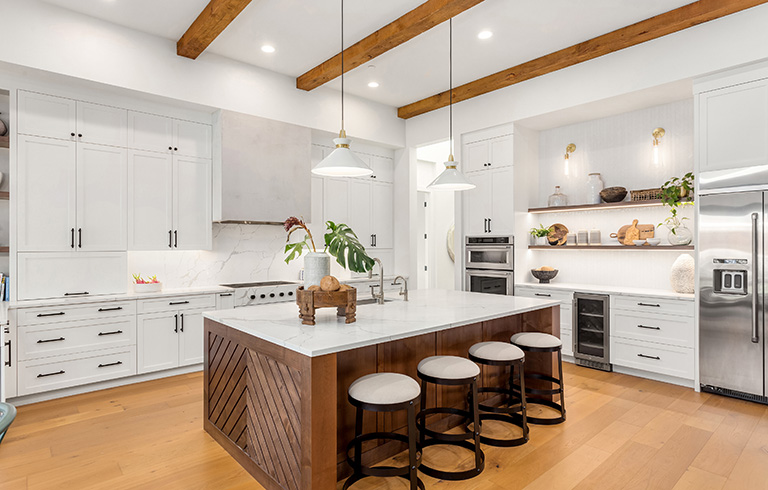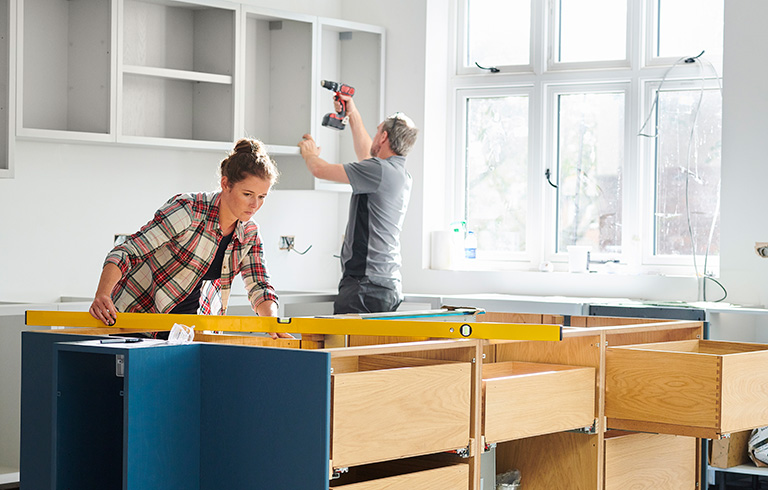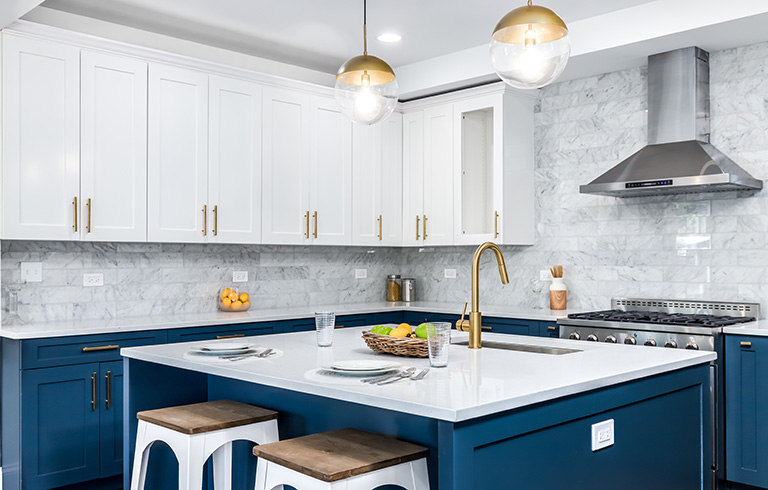
Budgeting Guide
9 Best Ways to Budget and Pay for Your Kitchen Remodel
Kitchen Remodel Cost
Remodeling your kitchen is an option to elevate the aesthetics and functionality of your home without having to move—and it also adds a lot of value to your property when it’s time to sell. However, a kitchen remodel can be a financial detriment if you don’t plan for it carefully. These kinds of costly projects can get out of hand easily, so make sure you’ve researched, budgeted and saved for yours.
If this is your first time undertaking this caliber of project, here are a few tips to help you understand how to save and pay for a kitchen remodel. These nine categories will give you the foresight needed to avoid common homeowner mistakes and help the renovation process stay manageable and affordable.

How to Budget for a Kitchen Remodel
Every remodeling project should start with a budget. If you stick with one, you can get the kitchen you’ve been dreaming of without breaking the bank.
Here are some tried-and-true budgeting tips to follow:
1. Calculate a budget based on home value
A kitchen remodel can cost anywhere from $5,000 to $35,000, depending on the project scope, home value, location and product selection. For example, if you’re redoing the entire kitchen and installing brand-new, top-of-the-line appliances, you’ll spend a whole lot more than if you were to simply refinish some cabinets and replace your flooring.
Experts say that, as a rule of thumb, plan to spend between 5% to 15% of your home value on a kitchen renovation. If your home costs $300,000, your kitchen renovation budget range should fall between $15,000 and $45,000. Staying in this range will help you maximize the return on your investment. Plan for the top of your budget range if you’re hiring a contractor and opting for high-end appliances. If you’re doing a lot of DIY and using inexpensive materials, on the other hand, you can plan for the lower end of your budget.


2. Allocate your budget to each remodeling aspect
Once you know how much money you have to work with, make a list of all the expenses you’re planning on and divide your budget among these categories. When working with a contractor, you’ll normally spend at least 17% on labor, so make sure to factor that into your total costs. The expenses of a kitchen remodel are listed below in order of highest to lowest price based on figures from the National Kitchen and Bath Association:
- Cabinets: 29%
- Labor: 17%
- Appliances: 14%
- Countertops: 10%
- Walls, doors, and windows: 9%
- Floors: 7%
- Lighting: 5%
- Design: 4%
- Plumbing and fixtures: 4%
- Miscellaneous: 1%
You don’t have to follow these figures exactly, these expenses serve merely as a guide for your own budget. If you’re not replacing windows, for example, you could allocate more money to nicer cabinets or appliances. Just be sure not to exceed your overall budget and adjust your figures if you end up spending more in one category than anticipated.
3. Plan for surprise expenses
If at all possible, set at least 20% of your total remodeling cost aside for unplanned expenses. Renovation projects rarely go as planned. For instance, you may run out of paint or flooring due to miscalculations or accidentally break something and have to replace it. Perhaps you’ll end up having to run water or electricity lines to a new area of the kitchen to accommodate a different floor plan than you originally wanted. This money will help cover the surprises that can’t be planned for, but hopefully you won’t have to use it.
4. Decide what work you can do yourself
Save yourself a significant chunk of change by doing what you can on your own. If you aren’t particularly handy, recruit friends and family who are. Together, you can tackle easier tasks, such as the demolition, prep work, appliance and hardware installation, painting, flooring or whatever else you feel comfortable doing.
5. Avoid unnecessary extra expenses
Unless you have wiggle room in your budget to accommodate cushy extras, resist the temptation to splurge on things you don’t need. The smart fridge may sound fun to have, but it may not be worth it if you end up spending thousands of dollars more than you’d planned and can no longer take that family vacation or maintain a steady emergency fund.

How to Pay for a Kitchen Remodel
Now that you know how to allocate a budget to remodeling expenses, it’s time to learn how to come up with the money for the remodel. It’s okay if you haven’t spent years saving up tens of thousands of dollars. Not many people have that kind of extra cash on hand. If it makes sense, pull funds from your savings, but keep in mind that this will deplete your emergency fund and it could take a while to build it back up.
In some instances, you can use credit to pay for the remodel—if you pay the balance off in a timely manner, this could boost your credit score without depleting your cash. If you’re going to carry a balance for a while, be sure to create a sound payoff plan and include the interest into your budget so you have a complete picture of how much you’re paying. Here are a few ways to use credit for your kitchen remodel in a smart way.
6. Consider a HELOC
A home equity line of credit, also known as a HELOC, is a flexible option for financing your kitchen remodel. You will need sufficient home equity in your house to qualify for these loans and, potentially, some cash on hand for closing expenses. Because the loan is secured by your home, they typically come with low rates. A HELOC also allows you to borrow and repay only what you need, making them great for projects like yours.
7. Apply for a personal loan
Personal loans are unsecured loans with higher interest rates, but they have longer repayment periods, which lowers the payment amounts. It’s easy to apply for personal loans, and you can generally borrow up to $50,000, depending on your credit score, current debt and income. Shop around with different lenders to find the most competitive interest rates.


8. Pay with a low-interest credit card
Credit cards can be an option for low-budget kitchen remodels. Some credit card companies offer 0% interest for a limited time as an opening incentive. If you’re going to use a credit card with this type of offer, make sure that the credit limit is high enough for your needs, you have a solid handle on your budget and that you're capable. If you can pay the credit card off within the 0% interest timeframe, you’ll be able to finance your kitchen remodel without paying a lump sum, without interest and without emptying your savings account—all while boosting your credit score with consistent on-time payments.
9. Apply for federal programs
The Federal Housing Administration offers a fixed-rate Title Property Improvement Loan which can be used for repairs and improvements on single-family homes. You can borrow up to $7,500 without collateral. Any amount over this will be secured by your home with the maximum loan amount being $25,000. There are no income limits or minimum credit requirements, but the U.S. Department of Housing and Urban Development will verify your employment and ensure that you aren’t delinquent or in default on any other federal loans.
Planning a kitchen remodel?
For additional guidance on how to save and plan for your kitchen remodel, contact Mountain America Credit Union today.
Schedule an appointmentApply for a HELOC